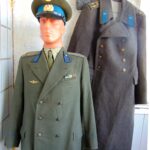The Cold War is an established term and a very important period in the history after the Second World War. When it started and when it ended, there are no clear dates, and now more and more people say that it never ended, but a logical continuation, version 2.0, appeared. From a practical point of view, for the museum personnel, the collectors, the historians, the tourists and the ordinary people in general, the Cold War has a certain structure and sections, which we display below.
As the beginning of the Cold War, we will consider September 9, 1945, the military parade of the still Allies in Berlin. The passage of Soviet armored vehicles was completed by Soviet heavy tanks IS-3, which shook everything around with their rumble. From that surprise, according to the legend, Churchill’s favorite pipe fell out of his mouth and he said that “There will be a new world war.” Prior to this, in his speeches, Churchill had also made predictions about the Soviets, as well as his representatives among the Disarmed Enemy Forces (DEF) and Displaced Persons (DP) Camps in Austria. During the disarmament at the end of May 1945, the former allies of the Germany, the Cossacks Domanov and von Panwitz, were promised that they would be dressed in the English uniforms, given the new weapons and they would continue the armed struggle against their enemies – the Stalinist Soviets. Stalin and his NKVD made the certain efforts to prevent this from happening and the “Tragedy of Lienz” occurred, which the British and American officers themselves later regretted. But another unit, the Russian Security Corps, was not handed over to Stalin for reprisals; its officers later served in the US Army. In 1953, the project of using this corps as the basis for creating the army of the future Free Russia during the Allied war against the USSR was considered.
We will divide the history of the Cold War into some conditional periods, which are associated both with the reign of Soviet leaders and with certain important world events. Of particular importance is also the development of military equipment and even the change of uniforms with weapons. It is according to this scheme that we recommend making temporary and permanent exhibitions at the Army Museum and other places. Our encyclopedia is based primarily on our own archives, documents, artifacts and extensive experience of traveling to memorable places. In this regard, we divide our guide into the corresponding sections:
– Chronology of events, local wars and battles, special secret operations.
– Soviet ideology and propaganda, Marxist-Leninist philosophy
– Armament, equipment, military equipment, including tanks, airborne forces and strategic missile forces.
– Documents, books, brochures, manuals, military manuals, magazines, newspapers.
– Uniform, insignia, awards, certificates
– Scale models of military vehicles, the children’s toys and VIP gifts for the bosses
– Photo case in the USSR and our own Photo Archive
– Guides and descriptions of military museums in the USSR, France and other countries
– Virtual tours of memorable places.
Part I, “Stalin era” 1945-1953
In reality, the hostile attitude of the US and Great Britain towards Stalin and the USSR began, or rather, continued immediately after the 1917 revolution and intervention, when real battles took place between the Soviets and the British-American troops in Russia. The armed battles ended, hatred of the Soviets remained, but this did not prevent Great Britain and the United States from selling automobile plants, tanks, aircraft and other strategic goods to the USSR. The political background remained the same – the victory in World War II did not cancel the repressions and the search for “enemies of the people”. Another wave of repression went against doctors, Jews and even war veterans, such as the writer Alexander Solzhenitsyn. The Gulag worked as before the war. The centers of resistance to the Stalinist regime remained only in the Baltic States and Western Ukraine, “forest brothers.” All the people were under the complete control of the Soviet special services, renamed the MGB. External secret operations were carried out by the method of covert poisoning with imitation of natural death. Most of these cases have not been declassified so far. Beginning in 1945, there was a real threat of an open war between the Allied countries against the USSR, which was facilitated by the presence of a nuclear bomb and carriers in the United States. Stalin built up his armor fist – he created new heavy and super-heavy tanks of the IS series in order to capture the whole of Europe at the right time. After the successful theft of the secrets of a nuclear bomb, the USSR began to develop carriers – strategic long-range bombers. At the same time, they began to create launch vehicles based on prototypes and V-2 documentation exported from Germany. A huge number of German factories, including military ones, as well as prominent designers, received the Soviets as trophies. Appeared “Soviet” cars, cameras and even a Kalashnikov assault rifle, the authorship of which has not yet been clarified.
- HQ colonel Teteryadchenko everyday uniform, 1960 (Cold War Museum USA)
The main features of this period were new military doctrines, improved knowledge of warfare under the use of nuclear weapons, and even the introduction of new uniforms for tankers and pilots in 1949. Existing bomb shelters based on deep underground stations with minor modifications were quite suitable for nuclear war. The Moscow metro has become an even more important strategic facility.

